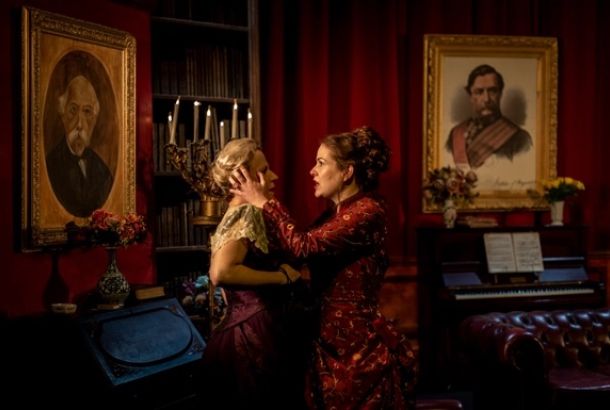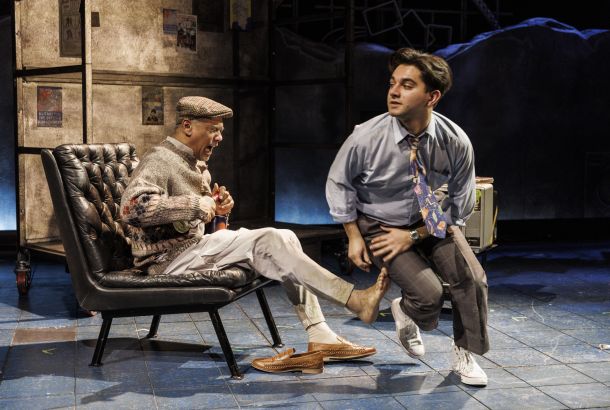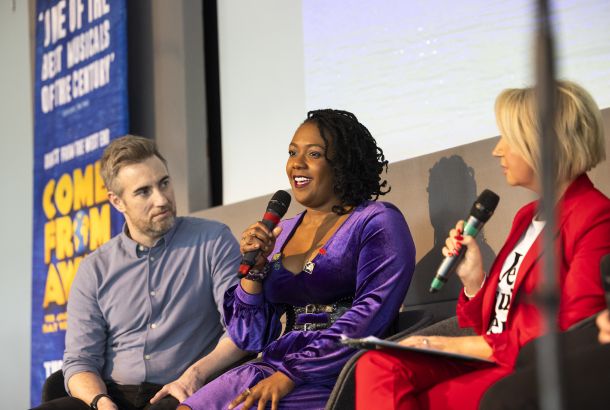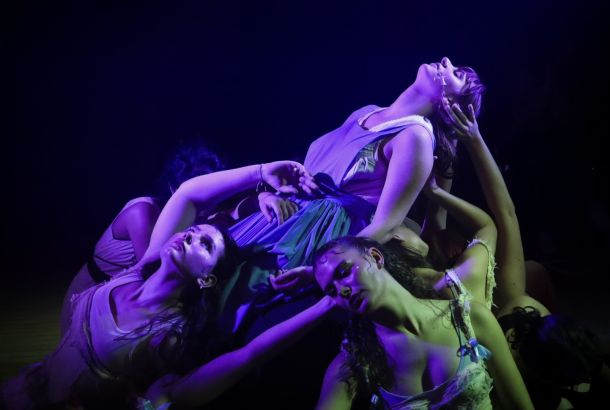Review: Opera North – The Cunning Little Vixen

Imagine a sunny morning in 1920, when a Czech composer named Leoš Janáček opened his daily newspaper, People’s News (Lidové noviny), to its comic section. Little did he know that this moment would inspire him to create a masterpiece that would leave a lasting impact on the world of opera.
The strip cartoon was The Adventures of Vixen Sharpears (Liška Bystrouška), a little fox who, after being captured, escapes to become a leader of the forest’s animals until she meets a tragic end.
This story stuck with Janáček, and on 6 November 1924, his opera premiered at the National Theatre Brno. Only four years later, its final scene was performed at the composer’s funeral. Then, almost a century later, I watched it at The Lowry, performed by Opera North. I dare to say that the performance left a similarly heavy impact on me as the cartoon had on Janáček.
The Cunning Little Vixen is a complex work that delves into many layers of meaning and symbolism. It explores the relationship between humans and nature (possibly inspired by Romantic literary tradition) and touches on political ideas such as feminism, social disobedience, exploitation, and capitalism. These themes were important and divisive social topics of the early twentieth century, making the opera even more thought-provoking and emotionally resonant at the time, as well as today. For example, in this opera, which was written just a few years after the Red Revolution and the Suffragettes’ victory of women’s right to vote, we hear openly political duets:
[Rooster] ‘You must be disciplined to boost your productivity (on the) egg mass-production line. Keep working, girls! Lying feminist!’ [Vixen] “Listen, sisters, why do you still obey him? You have let him enslave you. This is worker exploitation. Sisters, sisters, down with the social structure. Build a better world, build a world where we’re all equal, free, and liberated. This chauvinistic exploits your body for his profit. I can’t stand such an attitude, all this conservatism.” (see the full libretto here)

The Cunning Little Vixen is a stunning piece that effectively blends themes of social and political commentary with a unique and immersive musical experience. Its narrative boasts a wide array of vibrant characters, including the Forester, the Headmaster, the Priest, and various animals that reside in the forest.
The passage of time is a central theme here, as we see the characters experience the changing seasons and rhythms of the natural world. The use of dance and choral interludes reinforces this sense of organic growth and change. In the final scene, the vixen’s daughter takes up her mother’s mantle as the leader of the forest animals, emphasising the cyclical nature of life and the continuity of the natural world. The score brings these characters to life, imbuing their stories with both excitement and poignancy.
Janáček’s music captures the essence of the natural world indeed, reflecting the emotions and yearnings of the characters in a compelling manner, from the opening melodies to the lively dance sequences. It is a unique blend of Moravian folk music, classical tonality, modes, and avant-garde harmonies that give it an exciting and forward-looking feel. Furthermore, the declamatory singing style (along with the libretto itself), which imitates the sounds of the animals (e.g. barking, howling, chirping, and their general speech patterns), gives the opera a unique and immersive atmosphere.
The opera’s narrative is thus imbued with both excitement and poignancy by the music, which captures the essence of the natural world, reflecting the emotions and yearnings of the characters in a compelling manner, from the opening melodies to the lively dance sequences.
Janáček also developed his compositional technique that he called ‘sčasovka’ (timer): short but repeated ‘unfinished’ motifs, which foreshadowed Minimalism that came about decades later. It is not surprising that this opera became a landmark of 20th-century music, considering that some experimental opera concepts were also woven into the piece’s fabric, including ballet, instrumental interludes, and mime.
However, what really makes this opera stand out is its metaphorical characters. Sharpears represents freedom and the natural order that is threatened by human intervention (similar to James Cameron’s Avatar). She is an allegory of socialist ideas, gender equality, and activism. Her desire for autonomy and agency in the face of societal and cultural pressures is a theme that still resonates today.
Despite being a predator, she possesses humanoid attributes, while the oppressive forester is the wild creature of instinct with an urge to dominate. Here, while sympathising with the protagonist, one might also want to remember some politicians’ preaching while only serving themselves (i.e. Sharpears eats the chickens after encouraging them to rise up against their oppressors).
The classification of the opera as either buffa (comic) or seria (tragic) is a subject of debate, as it encompasses elements of both genres, being both serious and juvenile. Despite the lively presence of woodland creatures, the story is not simple or charming, as themes of death, unrequited love, and thwarted passion are woven into it. The animals and insects on stage are portrayed as more relatable and humane than the male characters who, on the other hand, are preoccupied with their own shortcomings and disappointments.
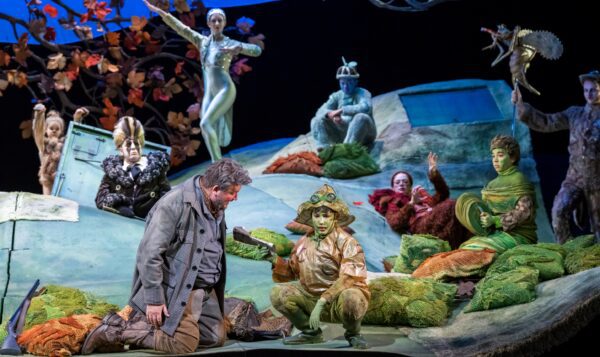
The forest set was intricately designed and multi-functional, complete with detailed features and smart transformations. Maria Bjornson, who gained fame for her work on the original West End production of Phantom of the Opera, designed an outstanding set for the production that captivated the audience. The set design featured a steep drop at the front, while steps at the back and sides allowed the characters to move on and off the stage with ease, making the transitions seamless.
As the audience entered the theatre, they were greeted by a stunning green patchwork of rolling hills, adorned with green mottled cushions in the hollows. The backdrop depicted a row of distant black hills, and above them was a clear blue sky, which provided a stunning contrast to the lush green hills.
As the story unfolds, various creatures are introduced, and many of them are portrayed by children, which added a playful element to the production. For instance, the audience meets Badger, a character with a distinctive black face and a white stripe down the middle, who pops his head out of his lair located at the centre of the hills. Bjornson’s extraordinary set design was an integral part of the success of the production, and it provided a stunning visual experience that transported the audience into the world of the play.
The costumes were equally impressive, featuring expertly crafted masks and body suits that brought the animal characters to life. Nick Chelton’s striking lighting effects created a magical atmosphere, capturing the changing seasons and leaving the audience in wonder. Overall, the ambience of the opera was truly remarkable, with the meadow, where the animals dwelt seamlessly, transforming into a local inn for the humans.
David Pountney’s exceptional direction set the stage for a truly unforgettable performance, complemented by Andrew Gourlay’s masterful conducting that perfectly captured the essence of the evening. Elaine Tyler-Hall’s choreography added a new dimension of depth to the production: her use of the puppets in her choreography was simply brilliant. The static puppets, manipulated by cast members in the same costumes, added a sense of innocence to the production, as if it were a playful game of dress-up.
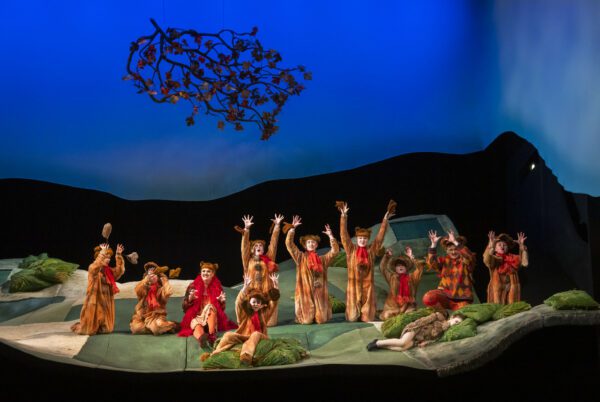
The production featured an outstanding cast and crew that brought the story to life with their impeccable talent. Erin Pritchard delivered a captivating portrayal of the protagonist, Vixen Sharpears, capturing the fox’s untamed nature yet adding an innocent charm to the character with her youthful tone, which was complemented by Heather Lowe (Sharpears’ husband): their duet was an absolute delight with Lowe’s mezzo-soprano voice adding a touch of depth to their chemistry. James Rutherford‘s performance as the Forester was truly outstanding. He effortlessly showcased his profound connection with the animal kingdom, revealing his own emotional journey and growth throughout the story.
The other male characters, the Priest (played by Henry Waddington) and the Schoolmaster (Paul Nilon), were similarly nuanced, reflecting the complexities of human nature and society. Meanwhile, Callum Thorpe’s portrayal of the Poacher was truly impactful, with his menacing and chilling presence leaving a lasting impression: the scene where he shoots Vixen was particularly heart-wrenching. Overall, this performance was a masterpiece, with every actor bringing their best to the stage and leaving the audience breathless.
Upon experiencing a rendition of this masterpiece, I was left completely amazed by the sheer beauty and intense emotional impact of Janáček’s musical composition, as well as the exceptional staging and captivating visuals. In conclusion, The Cunning Little Vixen seamlessly blends themes of social and political commentary with a unique and immersive musical experience. The characters are memorable, the music is innovative, and the themes are timeless.
The opera truly deserves its place among the great works of the genre, and Opera North’s performance ranks among the greatest renditions of the piece. With its beautiful music, stunning visuals, and complex themes, Janáček’s work stays with the audience long after the final notes have faded away. The exceptional talent of Opera North’s cast and crew brought this production to life, leaving a lasting impact on all those who were fortunate enough to witness it. This was truly an unforgettable experience for the senses that will remain with me for a long time to come.
Opera North’s The Cunning Little Vixen tours the UK until March 31.
